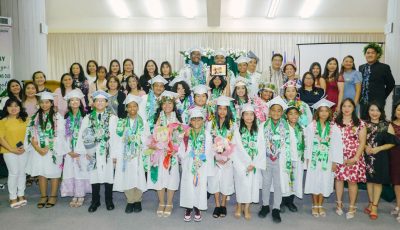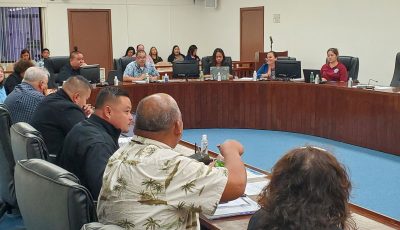‘Yes’ to HLI 18-12 will expand PSS Kindergarten’s accessibility’
Voting “yes” to House Legislative Initiative 18-12 this November will expand the accessibility of the Kindergarten program of the Public School System, making it available to all elementary schools on Saipan, Tinian, and Rota.
PSS’ Kindergarten program is a program of instruction of the Board of Education and is available within the school district for all 5-year-olds. However, due to lack of funding, PSS’ plan to expand this free program for all 5-year-old children has been curtailed in the last decade.
The government’s downward revenue trend has significantly impacted plans to expand public school facilities on Saipan, Tinian, and Rota—primarily to build more classrooms and hire more highly qualified teachers for the program, among others.
Making the program readily available to 5-year-olds hinges upon the availability of additional support and resources. If granted, this will ensure that all 5-year-olds will seamlessly transition to grade 1 through Head Start and Kindergarten.
H.L.I. 18-12 proposes to increase the minimum funding level for public education by an additional 10 percent, from the current 15 percent to 25 percent.
This will be voted on at the Nov. 3 general elections.
“The value of early childhood education is very critical. This is about student readiness and arming them with the necessary tools early,” Board of Education chair Herman T. Guerrero explained.
Education Commissioner Dr. Rita A. Sablan agrees. “It is about getting every child ready to learn and develop their social, emotional, and physical skills,” Sablan said.
Admission numbers
Every year, between 200 and 250 5-year-old children do not attend Kindergarten classes. Instead, they proceed straight to grade 1.
Student-enrollment data culled by PSS over the years reflect a reverse trend of admissions: there are more grade 1 enrollees than Kindergarten.
As a result, there is a learning gap for this age-group that skips Kindergarten to proceed straight to first grade.
In the last 12 years, PSS has identified a growing number of 5-year-olds enrolling straight to grade 1 right after completing Head Start.
In school year 2001, there were 770 enrollees for grade 1— higher than the same school year’s Kindergarten enrollment of 578. The enrollment number represents all 10 elementary schools on Saipan, Tinian, and Rota.
In 2002, the number climbed to 831 for grade 1 enrollees while Kindergarten student enrollees were at 591.
In 2003, grade 1 enrollment was at 828 and Kindergarten was at 599. In 2004, grade 1 enrollment was at 921 and the number of Kindergarten children was at 686. This was the year when PSS breached the 11,000-total enrollment mark.
By 2005, when public schools’ enrollment was at an all-time high (11,718) the enrollees for first grade was at 883 and Kindergarten was at 727.
The biggest number of children “skipping” Kindergarten and proceeding straight to first grade was in 2006: 940 enrollees for grade 1, while Kindergarten enrollees totaled 726.
Halfway through the last 12 years, admission numbers for Kindergarten continued to plummet while grade 1 enrollees were at a steady climb.
In 2007, Kindergarten enrollees dropped to 689 while grade 1 enrolment was at 836. A year after (2008) there were only 614 5-year-olds admitted to the Kindergarten program but grade 1 enrollment was at 830.
The varying figure continued in 2008: 632 admissions for Kindergarten and 766 for grade 1.
There were 604 children enlisted for the Kindergarten program in 2009 while a much-higher number, at 775, for grade 1.
In succeeding years, these numbers were replicated: 604 for Kindergarten students and 775 grade 1 students in 2010; 608-to-736 in 2011, and 582-to-745 by school year 2012-2013.
By the close of 2013-2014, Kindergarten admission was a low 544 while grade 1 enrollment was at a high 770.
“As you can see on the actual data, this translates to limited enrollment because there is simply not enough resources to allow us to expand our facilities to accommodate more 5-year-old children to attend our Kindergarten program and to hire highly qualified teachers to adequately staff our teaching pool,” explains Sablan.
Guerrero pointed out that in voting for H.L.I. 18-12, it would essentially translate to compulsory full-day, full-time Kindergarten program.
“We have early childhood curriculum—which is designed by our school system for a seamless transition from pre-school to grade one. But with [the current situation we are facing] there is disconnect when our children skips Kindergarten,” explained Guerrero.
H.L.I. 18-12, if approved by voters, will allow for 200 to 250 additional 5-year-old children to be admitted into the Kindergarten program.
Importance
The PSS-BOE’s investment for a full-day, full-time Kindergarten is validated by existing studies and research, mainly the need for pre-school programs to ensure that children have the “range of background and experience” to meet their educational needs and reach their full potential.
The U.S. Department of Education has acknowledged that “fewer than three in 10 4-year-olds are enrolled in high quality preschool programs.”
“Yet the importance of early learning is clear. Studies prove that children who have rich early learning experiences are better prepared to thrive in Kindergarten and beyond,” the USDOE pointed out. (PSS)



























